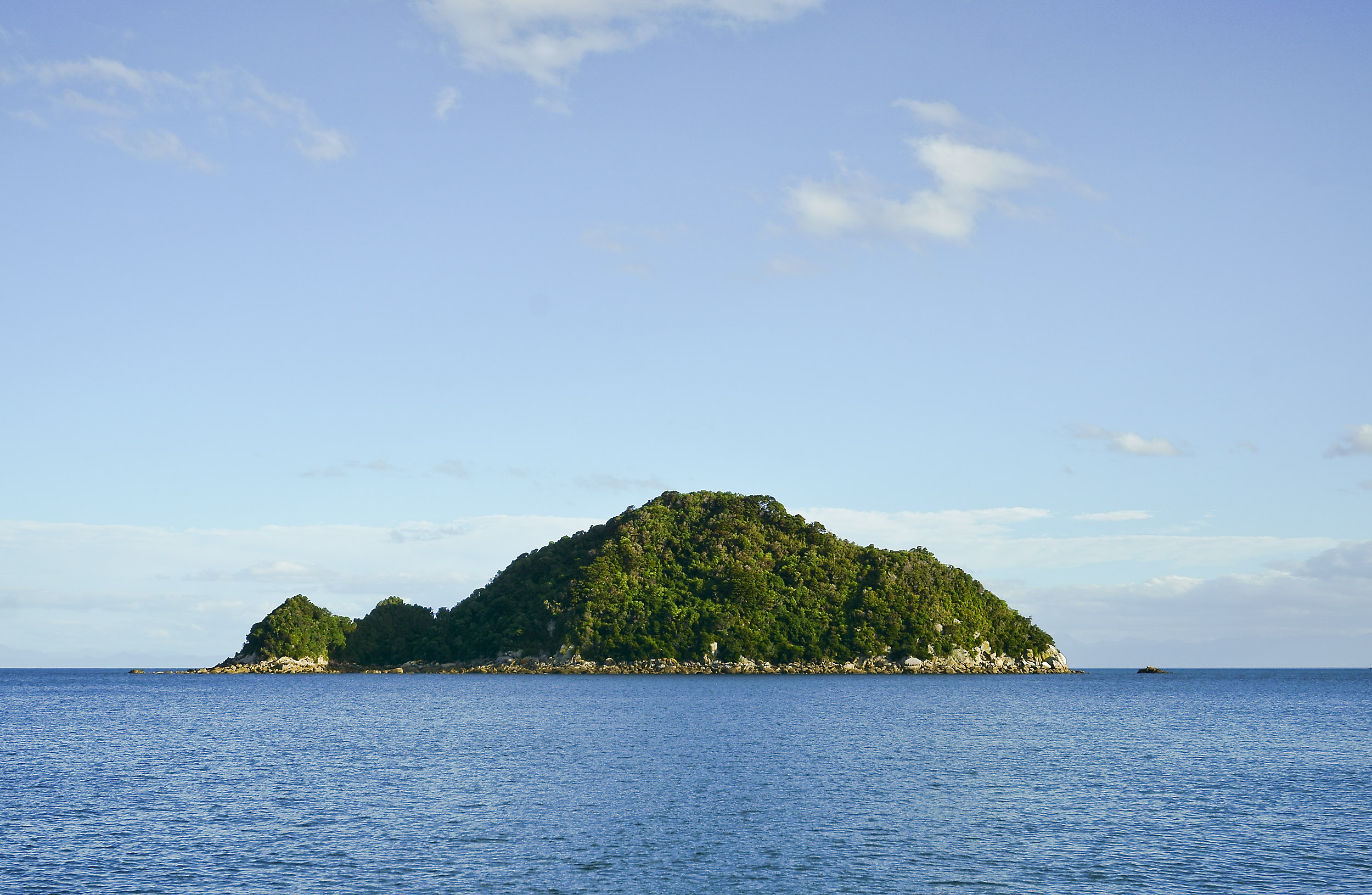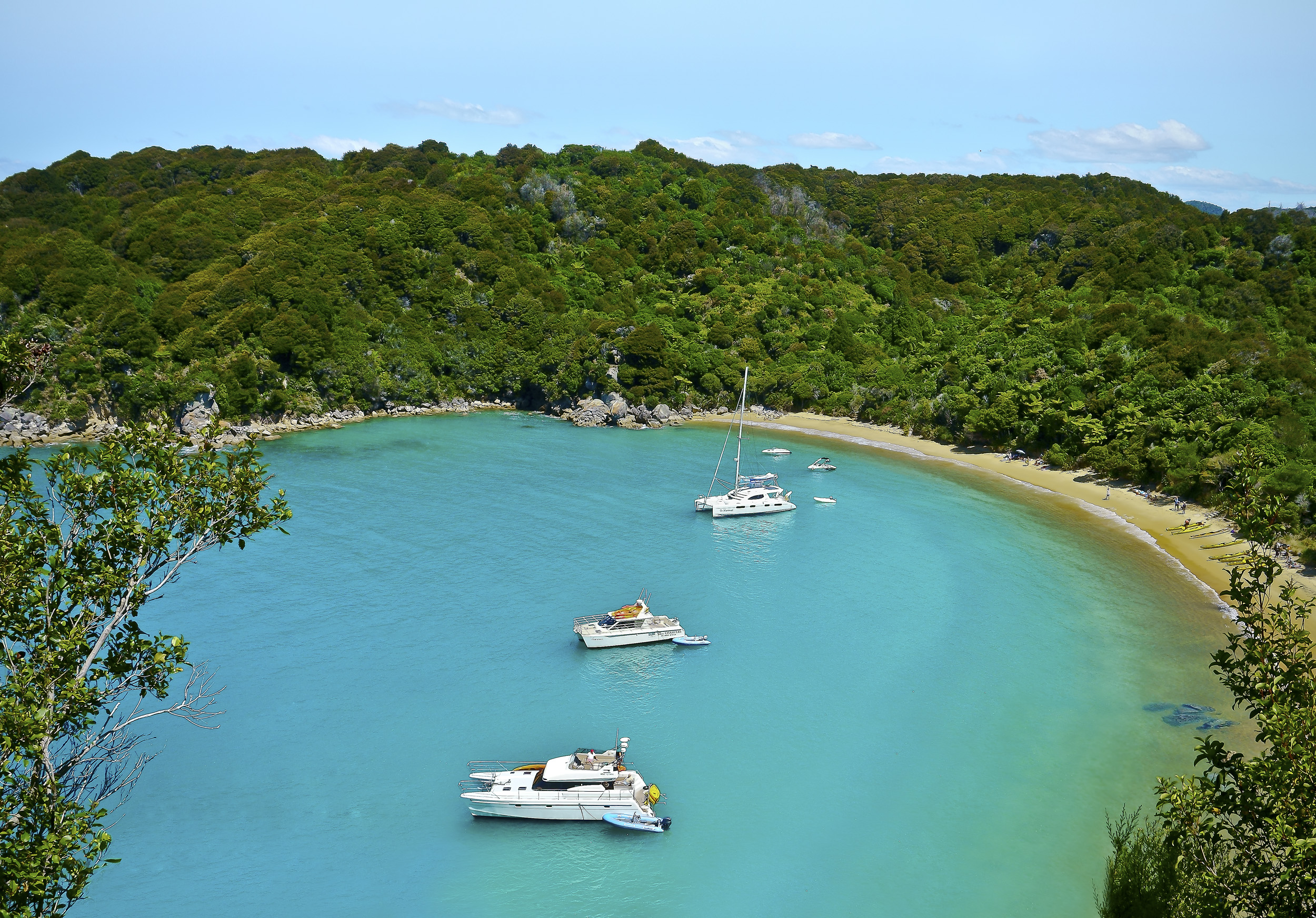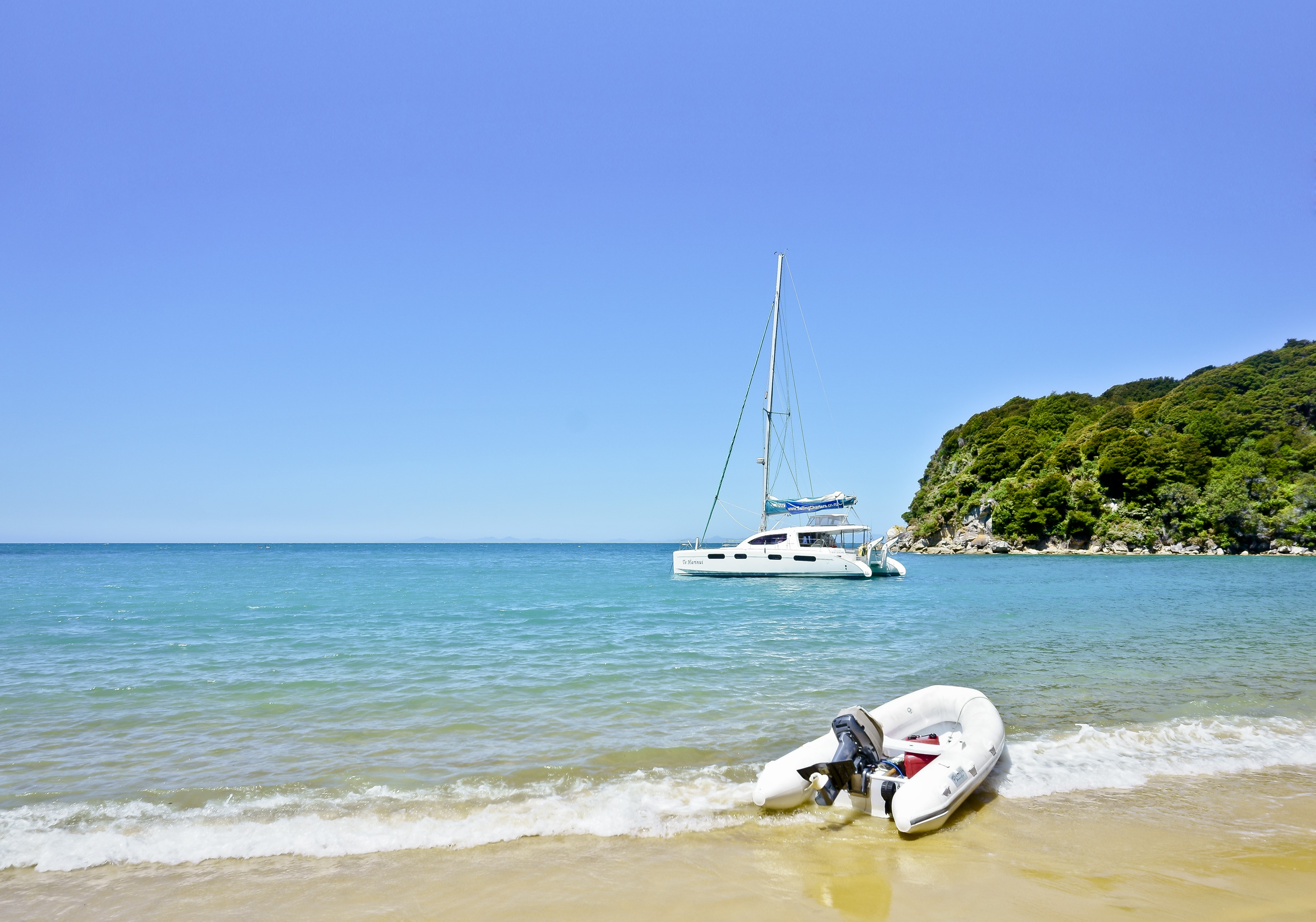Setting Sail in Abel Tasman National Park
This January, whilst New Zealand was being attacked by unseasonable wild storms, four intrepid travellers decided to take to the sea. Fortunately, the voyage was along the north coast of the South Island, to the famed Abel Tasman National Park. Surrounded on all sides by mountains, the area’s microclimate produced perfect conditions for a leisurely sailing expedition.

Ignorant of the havoc across the ranges, and with the sun’s kaleidoscope shimmer dancing on the ripples of Kaiteriteri harbour, we found ourselves waiting to be taken from the beach by motor dinghy to board the magnificent Te Harinui.
Abel Tasman Sailing Adventures operates five catamarans: three used for day trips (Alley Cat, Stray Cat and Mystify); the 13.5-metre Jamarh; and its newest addition, the 14.1-metre, eight-berth sailing catamaran, Te Harinui. When asked about the latter, company directors Jane-Maree and Martin Holmes glow with pride. Te Harinui — Māori for ‘Great Joy’ — is a beauty, both an asset to the enterprise and a joy for her owners.

She’s a joy, too, for those with the opportunity to climb aboard. To the aft is a covered outdoor seating area, which gives way to an enclosed lounge/dining room and well-stocked galley. Four private and comfortable double bedrooms sit below deck, all with ensuite bathrooms. To the fore is an open deck where passengers may sit under the spinnaker and, through eyes squinted against the wind-whipped sea spit, peer at the rugged coastline.
Following a brief investigation of our home for the next three days, we are all invited by Martin — our captain, host and tour guide — to join the obligatory safety briefing. Once complete, Martin steers Te Harinui northward out of Kaiteriteri harbour to a more picturesque setting to discuss our itinerary for the next few days. We then set sail and make our way slowly along the coast for the short trip to Split Apple Rock.

A little way out into the waters of Towers Bay, we come across the Split Apple: a rock which, through a phenomenon of geology, managed first to form as a not-quite-perfect sphere and subsequently became cleaved along a clean break through its centre. Looking northwest from here, we see the mysterious ‘Fairy Caves’, a series of dark tunnels that only intrepid swimmers dare to investigate.
As we head towards the national park boundary, we witness Te Harinui in full splendour for the first time. Her engine fires as Martin manoeuvres us out of the bay, then a whirring electric motor begins to lift the main sail up the mast. With some adjustments made from the cockpit — a few tugs of rope here and there — the sail ripples, then fills. The spinnaker is raised and by the time it catches the breeze we are skimming the waves with the salt-laced wind tugging at our hair and clothes.

We soon arrive at a calm strait between the mainland and Adele Island: the border of the national park. Adele Island is a conservation area famed for its birdlife and, so we are told, its spectacular dawn chorus. As we eat a light lunch, Martin tells us the story of Abel Tasman, the ill-fated Dutch explorer. After eating, we prepare to take to the dinghy and head ashore for a fate far preferable to Tasman’s (killed and eaten) crew members.
Landing at the secluded Te Pukatea Bay, we set off northward following a section of the popular Abel Tasman Coastal Track. A leisurely 45-minute stroll takes us through regenerating forest around the perimeter of a peninsula and back south into busy Anchorage bay. The passage is relentlessly beautiful: each break in the trees reveals postcard-perfect views of turquoise waters and rock-ringed white sands. Also common on this track — and the others we take over the following days — are hikers, loaded up like mules, faces troubled by sweat and consternation at the effort required to complete the full 60-kilometre hike. Such encounters almost make us feel guilty about the luxurious method by which we’ve arrived here.

Te Harinui and her captain are waiting for us on our arrival at Anchorage, the dinghy ready to take us aboard once again. We’re informed that the calm waters of the bay lend themselves well to a first night on the boat, so we agree to stay put until morning. Following a short siesta, we take to the deck again for drinks before dinner. Martin plays host now: accommodating and expansive, calling on the tales of adventure and local knowledge he possesses in equal abundance. When we appear satisfied, Martin surprises us with a final trip for the day, for which the dark is necessary.
The dinghy takes us ashore, to a cave network where colonies of glow-worms reside. Holding hands in the darkness, we slowly make our way over the beach to the cave opening. As we enter, we are met with an incredible sight: thousands of tiny luminescent creatures radiating a pulsing pale blue light. With a quick burst of the flashlight we are able to see the glow-worms in the flesh, congregating on the cave walls alongside some of New Zealand’s more grotesque insect residents — wetas. Switching the flashlight off, we remain for a few moments to gaze in awe at the starry tapestry, before returning to the ship.

The waters of the bay at Anchorage are as calm as promised and we sleep soundly through the night in our cabins, from which we emerge the next morning to the rich and inviting smell of coffee. Our plan is to sail the easy distance from Anchorage round a headland to Torrent Bay and investigate more of the national park.
After a leisurely breakfast, we lift anchor and start the engine, moving out into deeper water. Just as we reach water deep enough to follow the shoreline westward, a school of dolphins appears on all sides, leaping in their characteristic playful arcs over the surface of the water. They remain for a few brief moments then disappear, leaving us all in awestruck silence.

At Torrent Bay we alight to walk a longer section of the coastal track: a two-hour hike over undulating hills to Bark Bay. The track winds its way through native kanuka and manuka trees to its highlight: Falls River Swing Bridge. Spanning a small river-cut chasm, with the national park’s characteristic turquoise waters rushing underneath, the swing bridge leaps from one steep, bush-clad bank to the next, and is the stuff of fairytale adventure. The obligatory photo opportunity taken, we head on along the track to Bark Bay where lunch awaits.
After a short paddleboard expedition and a brief siesta, Martin, looking northward, points to a steady stream of white-capped waves beyond a headland. This indicates a high wind, he explains, and recommends that we remain on the sheltered side of the park for tonight. Happy to accept expert advice, after dinner we retreat a short way south to spend the night back in Torrent Bay.

Waking up the following morning, we realise with sadness that this is our final day aboard Te Harinui. Over a leisurely breakfast, Martin tells us more about his incredible sailing trips and near misses along the way. We then set off for another short section of the walking track, this time beginning at Awaroa Bay. The dinghy ride to the shore is an exciting one as the waters of Abel Tasman have sprung into life, the only indication of the storms that have been ravaging the country for the past few days.
Awaroa Bay is home to Pepper’s Awaroa Eco Lodge, a series of lovingly built and maintained buildings and gardens with a colourful history, nestled in the forest a few hundred metres back from the shore. We stop briefly at the lodge for refreshments before continuing our walk through more regenerating native forest towards Onetahuti Bay. Here the track becomes a sturdy boardwalk built across a swamp, abundant with colourful flora and fauna. We are met at the end of the track by Te Harinui once again and we climb aboard for our final meal.

As we are eating, rainclouds drift over us and the wind picks up. We agree to make use of the changing conditions and sail back south to Kaiteriteri to finish our trip. This time, unfurling the spinnaker is all that’s needed to pick up the necessary pace.
The drizzle settles as we disembark Te Harinui, feeling that it has been surely one of the best ways to experience Abel Tasman National Park, its true beauty being only discernible to the eyes of those lucky enough to travel by sea.
Karen and Paul were hosted by Abel Tasman Sailing Adventures.
